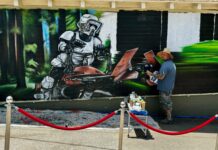
As Pam Jordan begins her third year as president of the Idyllwild Arts Foundation, she also assumes the role as head of school but still remains as positive and exuberant as the day she stepped onto campus in July 2014.
“After two years, it feels like home,” she said with a broad smile. “Absolutely feels like a community and even more, the more familiar I become with the process and people.”
The role of head of school is often part of the president’s responsibility. While it will be more demanding serving two functions, Jordan has the experience. She was head of school at the Chicago Academy of the Arts before coming to Idyllwild Arts. So she does not need “on-the-job” training.
“When Doug [Ashcraft, the former head of school] decided to step down, it was an opportunity to step into the role and to better understand the community, but from a place of knowing,” she said.
Now she will interact regularly with students, faculty, parents and contributors. It will be an active and busy year for her. As president, Jordan felt some distance from the students and she realizes how she missed that part of educational administration.
“I’ll see the students in the dorm and meet them at the dining hall, and able to hold conversations. I’ve missed that,” she disclosed. “It’s good to be back in touch with that part of campus.”
She also is pleased to have more time with the faculty. “Now I can work closely with department chairs in collaboration of the future of the school,” she stated. “I’ll learn what they see as a vision of the future.”
As the new head of school, Jordan is still president of the institution and responsible for implementing its strategic plan adopted in May. “The real work begins now,” she declared.
The vision statement offers several goals for Idyllwild Arts. The first one Jordan discussed was “… to produce thriving leaders for the 21st century.”
“How do we incorporate what made us so successful in the past and brought us today to prepare for changes in an unknown future?” is the goal all will be working on, she said, conveying her allegiance to the past, but recognition of a changing future.
“The students here are unlike any other students with whom I’m familiar,” she said proudly. “The first step will be to understand our depth and where we came from. What values do we have that cannot and should never change?” Striving to answer that question will require a learning experience across the whole campus, she expects.
As she has often said in the past, the Idyllwild Arts campus is unique in many ways — distance from an urban center, small town, forest environment and others. The physical campus is the foundation to the development of an extraordinary student body and what guides the graduates into the world.
“This is non-negotiable and fundamental to our experience. It is the magic of Idyllwild,” she stated. “Our alumni embody what is possible here.” Many times during her first year, she questioned “Why Idyllwild,” but today she understands and embraces this opportunity “because what we do is worthy of seclusion.”
The place is what attracted students and families to the summer program for three decades. “It transports you to another life,” she said, yet acknowledged that education evolves and transforms.
Educational institutions are changing, some faster than others. In the future, Jordan foresees more online classes and programs, more home schooling and even more charter schools. The implication is more focus on the desires of students. Her role, with the staff, will be to find IA’s focus in that new world.
“We better know who we are and what we stand for,” Jordan said, explaining how students and staff will need to handle the tide of change.
“More and more, art and society entertain ideas of global citizenship,” she pointed out. “IA communicates this in ways I’ve never seen elsewhere.” But still, the next step will involve discovering the next new vision for the school.
And Jordan’s enthusiasm grasps the need for patience to learn and to understand. Change, itself, can be rapid enough, but accepting its flow and feeling it requires time. The dedication of Lowman Hall, which occurred in September, is an example of this practice, she opined.
Construction was completed last winter. Rather than racing to an immediate dedication, the school used the hall, studied it, learned about it and consequently improved both the architectural and acoustical qualities before declaring it finished.
“Then we celebrated the incredible faculty and honor many donors,” she said.
While the new strategic plan has been adopted, Jordan will implement it in a fashion that honors and demonstrates the values embodied in the 70-year-old “art in society” institution.









